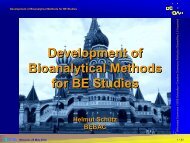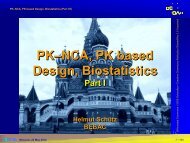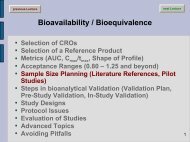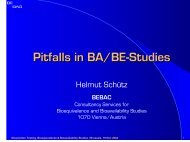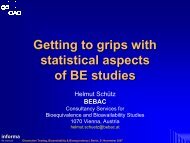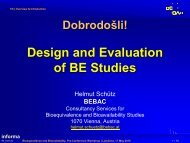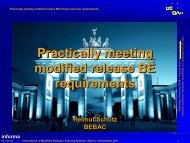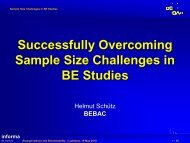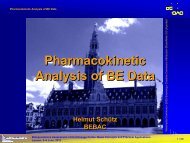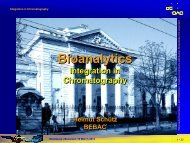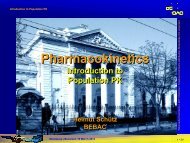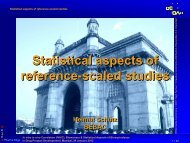Pharmacokinetic and Statistical Analysis of BE Data - BEBAC ...
Pharmacokinetic and Statistical Analysis of BE Data - BEBAC ...
Pharmacokinetic and Statistical Analysis of BE Data - BEBAC ...
Create successful ePaper yourself
Turn your PDF publications into a flip-book with our unique Google optimized e-Paper software.
<strong>Pharmacokinetic</strong> <strong>and</strong> <strong>Statistical</strong> <strong>Analysis</strong> <strong>of</strong> <strong>BE</strong> <strong>Data</strong><br />
<strong>Pharmacokinetic</strong><br />
<strong>and</strong> <strong>Statistical</strong> <strong>Analysis</strong><br />
<strong>of</strong> <strong>BE</strong> <strong>Data</strong><br />
Wikimedia Commons • 2009 Berthold Werner<br />
Creative Commons Attribution-ShareAlike<br />
3.0 Unported<br />
Helmut Schütz<br />
<strong>BE</strong>BAC<br />
1 st MENA Regulatory Conference on Bioequivalence, Biowaivers,<br />
Bioanalysis <strong>and</strong> Dissolution | Amman, 23 – 24 September 2013<br />
1• 50
<strong>Pharmacokinetic</strong> <strong>and</strong> <strong>Statistical</strong> <strong>Analysis</strong> <strong>of</strong> <strong>BE</strong> <strong>Data</strong><br />
To bear in Remembrance...<br />
Whenever a theory appears to you<br />
as the only possible one, take this as<br />
a sign that you have neither under-<br />
stood the theory nor the problem<br />
which it was intended to solve.<br />
Even though it’s applied science<br />
we’re dealin’ with, it still is – science!<br />
Karl R. Popper<br />
Leslie Z. Benet<br />
1 st MENA Regulatory Conference on Bioequivalence, Biowaivers,<br />
Bioanalysis <strong>and</strong> Dissolution | Amman, 23 – 24 September 2013<br />
2• 50
<strong>Pharmacokinetic</strong> <strong>and</strong> <strong>Statistical</strong> <strong>Analysis</strong> <strong>of</strong> <strong>BE</strong> <strong>Data</strong><br />
NCA vs. PK Modeling<br />
•<strong>Pharmacokinetic</strong> models<br />
•Useful for underst<strong>and</strong>ing the drug/formulation<br />
• Study design <strong>of</strong> BA/<strong>BE</strong>, e.g.,<br />
washout, accumulation / saturation to steady state<br />
•Drawbacks<br />
• Almost impossible to validate (fine-tuning <strong>of</strong> side<br />
conditions, weighting schemes, s<strong>of</strong>tware, …)<br />
• Still a mixture <strong>of</strong> art <strong>and</strong> science<br />
• Impossible to recalculate any given dataset using different<br />
s<strong>of</strong>tware – sometimes even different versions <strong>of</strong> the same<br />
s<strong>of</strong>tware!<br />
• Not acceptable for evaluation <strong>of</strong> <strong>BE</strong> studies!<br />
1 st MENA Regulatory Conference on Bioequivalence, Biowaivers,<br />
Bioanalysis <strong>and</strong> Dissolution | Amman, 23 – 24 September 2013<br />
3• 50
<strong>Pharmacokinetic</strong> <strong>and</strong> <strong>Statistical</strong> <strong>Analysis</strong> <strong>of</strong> <strong>BE</strong> <strong>Data</strong><br />
NCA: Single Dose<br />
•Noncompartmental methods do not rely on a<br />
PK (=compartmental) model<br />
•Also known as SHAM (Shape, Height, Area,<br />
Moments)<br />
•Metrics (plasma, single dose)<br />
• Extent <strong>of</strong> absorption (EU…), total exposure (US):<br />
AUC (Area Under the Curve)<br />
• Rate <strong>of</strong> absorption (EU…), peak exposure (US): C max<br />
• t max (EU…)<br />
• Early exposure (US, CAN): pAUC tmax ; AUC truncated at<br />
population’s (CAN: subject’s) t max <strong>of</strong> the reference<br />
• Others: C min , Fluctuation, MRT, Occupancy time, t lag ,…<br />
1 st MENA Regulatory Conference on Bioequivalence, Biowaivers,<br />
Bioanalysis <strong>and</strong> Dissolution | Amman, 23 – 24 September 2013<br />
4• 50
<strong>Pharmacokinetic</strong> <strong>and</strong> <strong>Statistical</strong> <strong>Analysis</strong> <strong>of</strong> <strong>BE</strong> <strong>Data</strong><br />
NCA: AUC<br />
•Recommended: lin-up/log-down trapezoidal rule<br />
•Hybrid <strong>of</strong> linear <strong>and</strong> log-linear<br />
•Sections with increasing or equal concentrations<br />
(C i+1 ≥ C i ) calculated by linear trapezoidal rule<br />
•Sections with decreasing concentrations<br />
(C i+1 < C i ) calculated by log-linear trapezoidal rule<br />
•Avoids bias in both absorption <strong>and</strong> distribution/<br />
elimination phases<br />
•Suitable for IV <strong>and</strong> EV<br />
•Suitable for multiphasic pr<strong>of</strong>iles<br />
1 st MENA Regulatory Conference on Bioequivalence, Biowaivers,<br />
Bioanalysis <strong>and</strong> Dissolution | Amman, 23 – 24 September 2013<br />
5• 50
<strong>Pharmacokinetic</strong> <strong>and</strong> <strong>Statistical</strong> <strong>Analysis</strong> <strong>of</strong> <strong>BE</strong> <strong>Data</strong><br />
NCA: AUC<br />
lin-up/log-down trapezoidal rule:<br />
arithmetic ~geometric means <strong>of</strong> concentrations<br />
0 2 4 6 8 10 12<br />
100<br />
100<br />
80<br />
80<br />
concentration<br />
60<br />
40<br />
60<br />
40<br />
20<br />
20<br />
0<br />
0<br />
0 2 4 6 8 10 12<br />
time (h)<br />
1 st MENA Regulatory Conference on Bioequivalence, Biowaivers,<br />
Bioanalysis <strong>and</strong> Dissolution | Amman, 23 – 24 September 2013<br />
6• 50
<strong>Pharmacokinetic</strong> <strong>and</strong> <strong>Statistical</strong> <strong>Analysis</strong> <strong>of</strong> <strong>BE</strong> <strong>Data</strong><br />
NCA: AUC Extrapolation<br />
•AUC 0–∞<br />
•Unweighted log-linear regression <strong>of</strong> ≥3 data points<br />
in the elimination phase<br />
•Don’t rely on s<strong>of</strong>twares’ automatic methods;<br />
visual inspection <strong>of</strong> the fit m<strong>and</strong>atory<br />
•Extrapolation from AUC 0–t (regardless the method)<br />
AUC = AUC + C<br />
Cˆ<br />
∞ t or better AUC<br />
ˆt<br />
∞<br />
AUCt<br />
λ<br />
= +<br />
ˆt<br />
λ<br />
z<br />
z<br />
1 st MENA Regulatory Conference on Bioequivalence, Biowaivers,<br />
Bioanalysis <strong>and</strong> Dissolution | Amman, 23 – 24 September 2013<br />
7• 50
<strong>Pharmacokinetic</strong> <strong>and</strong> <strong>Statistical</strong> <strong>Analysis</strong> <strong>of</strong> <strong>BE</strong> <strong>Data</strong><br />
NCA: othero<br />
PK Metrics<br />
•Single dose<br />
•C max <strong>and</strong> t max directly from pr<strong>of</strong>ile<br />
•Metrics describing the shape <strong>of</strong> the pr<strong>of</strong>ile<br />
• Early exposure (US, CAN): AUC tmax = pAUC truncated at<br />
population (CAN: subject’s) t max <strong>of</strong> the reference<br />
• Biphasic MR formulations: pAUCs truncated at a prespecified<br />
cut-<strong>of</strong>f time point<br />
• FDA: Product specific guidances (methylphenidate,<br />
zolpidem)<br />
• EMA: All products<br />
Questions & Answers: Positions on specific questions addressed to the pharmacokinetics<br />
working party<br />
EMA/618604/2008 Rev. 7 (13 February 2013)<br />
http://www.ema.europa.eu/docs/en_GB/document_library/Scientific_guideline/2009/09/WC5<br />
00002963.pdf<br />
1 st MENA Regulatory Conference on Bioequivalence, Biowaivers,<br />
Bioanalysis <strong>and</strong> Dissolution | Amman, 23 – 24 September 2013<br />
8• 50
<strong>Pharmacokinetic</strong> <strong>and</strong> <strong>Statistical</strong> <strong>Analysis</strong> <strong>of</strong> <strong>BE</strong> <strong>Data</strong><br />
NCA: othero<br />
PK Metrics<br />
•Single dose<br />
•Metrics describing the shape <strong>of</strong> the pr<strong>of</strong>ile<br />
• C max /AUC<br />
• t 75% = POT-75 (Plateau time, Peak-Occupancy-Time 75:<br />
time interval where C(t) ≥ 75% <strong>of</strong> C max )<br />
• HVD = POT-50 (Half Value Duration, Peak-Occupancy-<br />
Time 50: time interval where C(t) ≥ 50% <strong>of</strong> C max )<br />
• Occupancy time, t ≥ MIC (time interval where C(t) is above<br />
some limiting concentration)<br />
1 st MENA Regulatory Conference on Bioequivalence, Biowaivers,<br />
Bioanalysis <strong>and</strong> Dissolution | Amman, 23 – 24 September 2013<br />
9• 50
<strong>Pharmacokinetic</strong> <strong>and</strong> <strong>Statistical</strong> <strong>Analysis</strong> <strong>of</strong> <strong>BE</strong> <strong>Data</strong><br />
Case Study (PPI)<br />
•Attempt to deal with high variability<br />
Powered to 90%<br />
according to CV<br />
from previous<br />
studies; 140 (!)<br />
subjects <strong>and</strong> to<br />
80% for expected<br />
dropout rate.<br />
Sampling every<br />
30 min up to<br />
14 hours<br />
(7,785 total)<br />
t max 15 h, C max 3.5×LLOQ<br />
1500<br />
500<br />
250<br />
50<br />
25<br />
1 st MENA Regulatory Conference on Bioequivalence, Biowaivers,<br />
Bioanalysis <strong>and</strong> Dissolution | Amman, 23 – 24 September 2013<br />
5<br />
First time C max<br />
t ½ 12 h<br />
0 4 8 12 16 20 24<br />
t lag 6h<br />
time (h)<br />
10 • 50
<strong>Pharmacokinetic</strong> <strong>and</strong> <strong>Statistical</strong> <strong>Analysis</strong> <strong>of</strong> <strong>BE</strong> <strong>Data</strong><br />
NCA: Multiple Dose<br />
•AUC τ (dosage interval τ ) or AUC ss,24h (if more<br />
than o.a.d. <strong>and</strong> chronopharmacological<br />
variation)<br />
•No extrapolation!<br />
•C ss,max <strong>and</strong> C ss,min directly from pr<strong>of</strong>ile<br />
•Peak-Trough-Fluctuation: (C ss,max –C ss,min )/<br />
C ss,av , where C ss,av = AUC τ /τ<br />
•Swing: (C ss,max –C ss,min )/C ss,min<br />
1 st MENA Regulatory Conference on Bioequivalence, Biowaivers,<br />
Bioanalysis <strong>and</strong> Dissolution | Amman, 23 – 24 September 2013<br />
11 • 50
<strong>Pharmacokinetic</strong> <strong>and</strong> <strong>Statistical</strong> <strong>Analysis</strong> <strong>of</strong> <strong>BE</strong> <strong>Data</strong><br />
<strong>BE</strong> Study Designs<br />
yes<br />
long half life <strong>and</strong>/or<br />
patients in unstable<br />
conditions?<br />
no<br />
no<br />
parallel design<br />
paired design<br />
cross-over design<br />
reliable informations<br />
about CV?<br />
yes<br />
no<br />
yes<br />
multi-arm parallel<br />
higher-order cross-over<br />
>2 formulations?<br />
•No scaling in parallel designs<br />
yes<br />
replicate design<br />
(reference scaling)<br />
fixed sample design<br />
CV >30?<br />
no<br />
2×2 cross-over design<br />
replicate (unscaled)<br />
two-stage design<br />
•Currently no two-stage design if<br />
•Parallel design<br />
•>2 formulations<br />
•Replicate design<br />
•Futility rules (i.e., maximum<br />
sample size) in two-stage designs<br />
problematic<br />
1 st MENA Regulatory Conference on Bioequivalence, Biowaivers,<br />
Bioanalysis <strong>and</strong> Dissolution | Amman, 23 – 24 September 2013<br />
12 • 50
<strong>Pharmacokinetic</strong> <strong>and</strong> <strong>Statistical</strong> <strong>Analysis</strong> <strong>of</strong> <strong>BE</strong> <strong>Data</strong><br />
<strong>BE</strong> Study Designs<br />
Information<br />
•The more ‘sophisticated’ a design is, the more<br />
information can be extracted<br />
•Hierarchy <strong>of</strong> designs:<br />
Full replicate (TRTR | RTRT or TRT | RTR), <br />
Partial replicate (TRR | RTR | RRT) <br />
St<strong>and</strong>ard 2×2 cross-over (RT | RT) <br />
Parallel (R | T)<br />
•Variances which can be estimated:<br />
Parallel: total variance (between + within)<br />
2×2 Xover: + between, within subjects <br />
Partial replicate: + within subjects (reference) <br />
Full replicate: + within subjects (reference, test) <br />
1 st MENA Regulatory Conference on Bioequivalence, Biowaivers,<br />
Bioanalysis <strong>and</strong> Dissolution | Amman, 23 – 24 September 2013<br />
13 • 50
<strong>Pharmacokinetic</strong> <strong>and</strong> <strong>Statistical</strong> <strong>Analysis</strong> <strong>of</strong> <strong>BE</strong> <strong>Data</strong><br />
<strong>Data</strong> Transformation?<br />
•<strong>BE</strong> testing started in the early 1980s with an<br />
acceptance range <strong>of</strong> 80% – 120% <strong>of</strong> the<br />
reference based on the normal distribution<br />
•Was questioned in the mid 1980s<br />
•Like many biological variables AUC <strong>and</strong> C max do not<br />
follow a normal distribution<br />
• Negative values are impossible<br />
•The distribution is skewed to the right<br />
•Might follow a lognormal distribution<br />
•Serial dilutions in bioanalytics lead to multiplicative<br />
errors<br />
1 st MENA Regulatory Conference on Bioequivalence, Biowaivers,<br />
Bioanalysis <strong>and</strong> Dissolution | Amman, 23 – 24 September 2013<br />
14 • 50
<strong>Pharmacokinetic</strong> <strong>and</strong> <strong>Statistical</strong> <strong>Analysis</strong> <strong>of</strong> <strong>BE</strong> <strong>Data</strong><br />
Density<br />
Sample Quantiles<br />
0.000 0.005 0.010 0.015 0.020 0.025 0.030 0.035<br />
20 40 60 80 100 120<br />
<strong>Data</strong> Transformation?<br />
MPH, 437 subjects<br />
0 50 100 150<br />
AUC [ng×h/mL]<br />
Shapiro-Wilk p= 1.3522e-14<br />
Normal Q-Q Plot<br />
Density<br />
Sample Quantiles<br />
0.0 0.2 0.4 0.6 0.8 1.0 1.2<br />
3.0 3.5 4.0 4.5<br />
MPH, 437 subjects<br />
2.5 3.0 3.5 4.0 4.5 5.0<br />
ln(AUC [ng×h/mL])<br />
Shapiro-Wilk p= 0.29343<br />
Normal Q-Q Plot<br />
Pooled data<br />
from real<br />
studies.<br />
Clearly in<br />
favor <strong>of</strong> a<br />
lognormal<br />
distribution.<br />
Shapiro-Wilk<br />
test highly<br />
significant for<br />
normal distribution<br />
(assumption<br />
rejected).<br />
-3 -2 -1 0 1 2 3<br />
Theoretical Quantiles<br />
-3 -2 -1 0 1 2 3<br />
Theoretical Quantiles<br />
1 st MENA Regulatory Conference on Bioequivalence, Biowaivers,<br />
Bioanalysis <strong>and</strong> Dissolution | Amman, 23 – 24 September 2013<br />
15 • 50
<strong>Pharmacokinetic</strong> <strong>and</strong> <strong>Statistical</strong> <strong>Analysis</strong> <strong>of</strong> <strong>BE</strong> <strong>Data</strong><br />
<strong>Data</strong> Transformation!<br />
Density<br />
Sample Quantiles<br />
0.000 0.005 0.010 0.015 0.020 0.025 0.030 0.035<br />
20 30 40 50 60<br />
MPH, 12 subjects<br />
0 50 100 150<br />
AUC [ng×h/mL]<br />
Shapiro-Wilk p= 0.29667<br />
Normal Q-Q Plot<br />
Density<br />
Sample Quantiles<br />
0.0 0.5 1.0 1.5<br />
3.0 3.2 3.4 3.6 3.8 4.0<br />
MPH, 12 subjects<br />
2.5 3.0 3.5 4.0 4.5 5.0<br />
ln(AUC [ng×h/mL])<br />
Shapiro-Wilk p= 0.85764<br />
Normal Q-Q Plot<br />
<strong>Data</strong> <strong>of</strong> a real<br />
study.<br />
Both tests not<br />
significant<br />
(assumptions<br />
accepted).<br />
Tests not<br />
acceptable<br />
according to<br />
GLs.<br />
Transformation<br />
based on<br />
prior knowledge<br />
(PK)!<br />
-1.5 -1.0 -0.5 0.0 0.5 1.0 1.5<br />
Theoretical Quantiles<br />
-1.5 -1.0 -0.5 0.0 0.5 1.0 1.5<br />
Theoretical Quantiles<br />
1 st MENA Regulatory Conference on Bioequivalence, Biowaivers,<br />
Bioanalysis <strong>and</strong> Dissolution | Amman, 23 – 24 September 2013<br />
16 • 50
<strong>Pharmacokinetic</strong> <strong>and</strong> <strong>Statistical</strong> <strong>Analysis</strong> <strong>of</strong> <strong>BE</strong> <strong>Data</strong><br />
Parallel designs<br />
•Two-Group Parallel Design<br />
Subjects<br />
RANDOMIZATION<br />
Group 1<br />
Group 2<br />
Reference<br />
Test<br />
1 st MENA Regulatory Conference on Bioequivalence, Biowaivers,<br />
Bioanalysis <strong>and</strong> Dissolution | Amman, 23 – 24 September 2013<br />
17 • 50
<strong>Pharmacokinetic</strong> <strong>and</strong> <strong>Statistical</strong> <strong>Analysis</strong> <strong>of</strong> <strong>BE</strong> <strong>Data</strong><br />
Parallel designs<br />
(cont’d)<br />
•Two-group parallel design<br />
•Advantages<br />
• Clinical part – sometimes – faster than X-over.<br />
• Straigthforward statistical analysis.<br />
• Drugs with long half life.<br />
• Potentially toxic drugs or effect <strong>and</strong>/or AEs unacceptable in<br />
healthy subjects.<br />
• Studies in patients, where the condition <strong>of</strong> the disease irreversibly<br />
changes.<br />
•Disadvantages<br />
• Lower statistical power than X-over (rule <strong>of</strong> thumb: sample size<br />
should at least be doubled).<br />
• Phenotyping m<strong>and</strong>atory for drugs showing polymorphism.<br />
1 st MENA Regulatory Conference on Bioequivalence, Biowaivers,<br />
Bioanalysis <strong>and</strong> Dissolution | Amman, 23 – 24 September 2013<br />
18 • 50
<strong>Pharmacokinetic</strong> <strong>and</strong> <strong>Statistical</strong> <strong>Analysis</strong> <strong>of</strong> <strong>BE</strong> <strong>Data</strong><br />
Cross-over<br />
over designs<br />
•St<strong>and</strong>ard 2×2×2 Design<br />
Period<br />
Subjects<br />
RANDOMIZATION<br />
I<br />
II<br />
Sequence 1 Reference Test<br />
WASHOUT<br />
Sequence 2 Test Reference<br />
1 st MENA Regulatory Conference on Bioequivalence, Biowaivers,<br />
Bioanalysis <strong>and</strong> Dissolution | Amman, 23 – 24 September 2013<br />
19 • 50
<strong>Pharmacokinetic</strong> <strong>and</strong> <strong>Statistical</strong> <strong>Analysis</strong> <strong>of</strong> <strong>BE</strong> <strong>Data</strong><br />
Cross-over<br />
over designs<br />
(cont’d)<br />
•Every subject is treated both with<br />
test <strong>and</strong> reference<br />
•Subjects are r<strong>and</strong>omized into two groups; one<br />
is receiving the formulations in the order RT<br />
<strong>and</strong> the other one in the order TR. These two<br />
orders are called sequences<br />
•Whilst in a paired design we must rely on the<br />
assumption that no external influences affect<br />
the periods, a cross-over design will account for<br />
that<br />
1 st MENA Regulatory Conference on Bioequivalence, Biowaivers,<br />
Bioanalysis <strong>and</strong> Dissolution | Amman, 23 – 24 September 2013<br />
20 • 50
<strong>Pharmacokinetic</strong> <strong>and</strong> <strong>Statistical</strong> <strong>Analysis</strong> <strong>of</strong> <strong>BE</strong> <strong>Data</strong><br />
Cross-over<br />
over design: Model<br />
Multiplicative Model (X-over without carryover)<br />
( X ) = ( µ ) + ( π ) + ( Φ ) + ( s ) + ( e )<br />
ln ln ln ln ln ln<br />
ijk k l ik ijk<br />
X = µπ ⋅ ⋅Φ ⋅s ⋅e<br />
ijk k l ik ijk<br />
X ijk : response <strong>of</strong> j-th subject (j=1,…,n i ) in i-th<br />
sequence (i=1,2) <strong>and</strong> k-th period (k=1,2), µ:<br />
global mean, µ l : expected formulation means<br />
(l=1,2: µ l =µ test , µ 2 =µ ref. ),<br />
π k : fixed period effects, Φ l : fixed formulation<br />
effects (l=1,2: Φ l =Φ test , Φ 2 =Φ ref. )<br />
1 st MENA Regulatory Conference on Bioequivalence, Biowaivers,<br />
Bioanalysis <strong>and</strong> Dissolution | Amman, 23 – 24 September 2013<br />
21 • 50
<strong>Pharmacokinetic</strong> <strong>and</strong> <strong>Statistical</strong> <strong>Analysis</strong> <strong>of</strong> <strong>BE</strong> <strong>Data</strong><br />
Cross-over<br />
over design:<br />
Assumptions<br />
Multiplicative Model (X-over without carryover)<br />
X = µ ⋅π<br />
⋅Φ ⋅s ⋅e<br />
ijk k l ik ijk<br />
•All ln{s ik } <strong>and</strong> ln{e ijk } are independently <strong>and</strong> normally<br />
distributed about unity with variances σ² s <strong>and</strong> σ² e .<br />
This assumption may not hold true for all formulations; if the<br />
reference formulation shows higher variability than the test<br />
formulation, a ‘good’ test will be penalized for the ‘bad’ reference.<br />
•All observations made on different subjects are<br />
independent.<br />
This assumption should not be a problem, unless you plan to<br />
include twins or triplets in your study…<br />
1 st MENA Regulatory Conference on Bioequivalence, Biowaivers,<br />
Bioanalysis <strong>and</strong> Dissolution | Amman, 23 – 24 September 2013<br />
22 • 50
<strong>Pharmacokinetic</strong> <strong>and</strong> <strong>Statistical</strong> <strong>Analysis</strong> <strong>of</strong> <strong>BE</strong> <strong>Data</strong><br />
Cross-over<br />
over designs<br />
(cont’d)<br />
•St<strong>and</strong>ard 2×2×2 design<br />
•Advantages<br />
• Globally applied st<strong>and</strong>ard protocol for bioequivalence,<br />
PK interaction, food studies<br />
• Straigthforward statistical analysis<br />
•Disadvantages<br />
• Not suitable for drugs with long half life (→ parallel groups)<br />
• Not optimal for studies in patients with instable diseases<br />
(→ parallel groups)<br />
• Not optimal for HVDs/HVDPs (→ Replicate Designs)<br />
1 st MENA Regulatory Conference on Bioequivalence, Biowaivers,<br />
Bioanalysis <strong>and</strong> Dissolution | Amman, 23 – 24 September 2013<br />
23 • 50
<strong>Pharmacokinetic</strong> <strong>and</strong> <strong>Statistical</strong> <strong>Analysis</strong> <strong>of</strong> <strong>BE</strong> <strong>Data</strong><br />
<strong>BE</strong> Evaluation<br />
•Based on the design set up a statistical model.<br />
•Calculate the test/reference ratio.<br />
•Calculate the 90% confidence interval (CI)<br />
around the ratio.<br />
•The width <strong>of</strong> the CI depends on the variability<br />
observed in the study.<br />
•The location <strong>of</strong> the CI depends on the<br />
observed test/reference-ratio.<br />
1 st MENA Regulatory Conference on Bioequivalence, Biowaivers,<br />
Bioanalysis <strong>and</strong> Dissolution | Amman, 23 – 24 September 2013<br />
24 • 50
<strong>Pharmacokinetic</strong> <strong>and</strong> <strong>Statistical</strong> <strong>Analysis</strong> <strong>of</strong> <strong>BE</strong> <strong>Data</strong><br />
<strong>BE</strong> Assessment<br />
•Decision rules based on the CI <strong>and</strong> the<br />
Acceptance Range (AR)<br />
•CI entirely outside the AR:<br />
Bioinequivalence proven<br />
•CI overlaps the AR (lies not entirely within the AR):<br />
Bioequivalence not proven – indecisive<br />
•CI lies entirely within the AR:<br />
Bioequivalence proven<br />
1 st MENA Regulatory Conference on Bioequivalence, Biowaivers,<br />
Bioanalysis <strong>and</strong> Dissolution | Amman, 23 – 24 September 2013<br />
25 • 50
<strong>Pharmacokinetic</strong> <strong>and</strong> <strong>Statistical</strong> <strong>Analysis</strong> <strong>of</strong> <strong>BE</strong> <strong>Data</strong><br />
<strong>BE</strong> Assessment<br />
180%<br />
180%<br />
160%<br />
160%<br />
140%<br />
140%<br />
120%<br />
120%<br />
100%<br />
100%<br />
80%<br />
80%<br />
60%<br />
60%<br />
1 st MENA Regulatory Conference on Bioequivalence, Biowaivers,<br />
Bioanalysis <strong>and</strong> Dissolution | Amman, 23 – 24 September 2013<br />
26 • 50
<strong>Pharmacokinetic</strong> <strong>and</strong> <strong>Statistical</strong> <strong>Analysis</strong> <strong>of</strong> <strong>BE</strong> <strong>Data</strong><br />
Add-on / Two-Stage Designs<br />
•Sometimes properly designed <strong>and</strong> executed<br />
studies fail due to<br />
•‘true’ bioinequivalence,<br />
•poor study conduct (increasing variability),<br />
•pure chance (producer’s risk hit),<br />
•false (over-optimistic) assumptions about variability<br />
<strong>and</strong>/or T/R-ratio.<br />
•The patient’s risk must be preserved<br />
•Already noticed at Bio-International Conferences<br />
(1989, 1992) <strong>and</strong> guidelines from the 1990s.<br />
1 st MENA Regulatory Conference on Bioequivalence, Biowaivers,<br />
Bioanalysis <strong>and</strong> Dissolution | Amman, 23 – 24 September 2013<br />
27 • 50
<strong>Pharmacokinetic</strong> <strong>and</strong> <strong>Statistical</strong> <strong>Analysis</strong> <strong>of</strong> <strong>BE</strong> <strong>Data</strong><br />
Sequential Designs<br />
•Have a long <strong>and</strong> accepted tradition in clinical<br />
research (mainly phase III)<br />
•Based on work by Armitage et al. (1969),<br />
McPherson (1974), Pocock (1977), O’Brien <strong>and</strong><br />
Fleming (1979), Lan & DeMets (1983), …<br />
•First proposal by Gould (1995) in the area <strong>of</strong><br />
<strong>BE</strong> did not get regulatory acceptance in Europe, but<br />
•new methods stated in recent guidelines.<br />
AL Gould<br />
Group Sequential Extension <strong>of</strong> a St<strong>and</strong>ard Bioequivalence Testing Procedure<br />
J Pharmacokin Biopharm 23(1), 57–86 (1995)<br />
1 st MENA Regulatory Conference on Bioequivalence, Biowaivers,<br />
Bioanalysis <strong>and</strong> Dissolution | Amman, 23 – 24 September 2013<br />
28 • 50
<strong>Pharmacokinetic</strong> <strong>and</strong> <strong>Statistical</strong> <strong>Analysis</strong> <strong>of</strong> <strong>BE</strong> <strong>Data</strong><br />
Sequential Designs<br />
•Methods by Potvin et al. (2008) first validated<br />
framework in the context <strong>of</strong> <strong>BE</strong><br />
•Supported by the ‘Product Quality Research<br />
Institute’ (members: FDA/CDER, Health Canada,<br />
USP, AAPS, PhRMA…)<br />
•Three <strong>of</strong> <strong>BE</strong>BAC’s protocols accepted by German<br />
BfArM, one product approved in 06/2011.<br />
Potvin D, Diliberti CE, Hauck WW, Parr AF, Schuirmann DJ, <strong>and</strong> RA Smith<br />
Sequential design approaches for bioequivalence studies with crossover designs<br />
Pharmaceut Statist 7(4), 245–62 (2008) DOI: 10.1002/pst.294<br />
1 st MENA Regulatory Conference on Bioequivalence, Biowaivers,<br />
Bioanalysis <strong>and</strong> Dissolution | Amman, 23 – 24 September 2013<br />
29 • 50
<strong>Pharmacokinetic</strong> <strong>and</strong> <strong>Statistical</strong> <strong>Analysis</strong> <strong>of</strong> <strong>BE</strong> <strong>Data</strong><br />
Review <strong>of</strong> Guidelines<br />
•EMA (Jan 2010)<br />
Acceptable; Potvin et al. Method B preferred (?)<br />
•Russia (Draft 2011)<br />
Acceptable (Methods B <strong>and</strong> C)<br />
•Canada (May 2012)<br />
Potvin et al. Method C recommended<br />
•FDA (Jun 2012)<br />
Potvin et al. Method C recommended<br />
API specific guidances: Loteprednol, Dexamethasone<br />
/ Tobramycin<br />
1 st MENA Regulatory Conference on Bioequivalence, Biowaivers,<br />
Bioanalysis <strong>and</strong> Dissolution | Amman, 23 – 24 September 2013<br />
30 • 50
<strong>Pharmacokinetic</strong> <strong>and</strong> <strong>Statistical</strong> <strong>Analysis</strong> <strong>of</strong> <strong>BE</strong> <strong>Data</strong><br />
Potvin et al. (Method B) B<br />
Evaluate <strong>BE</strong> at stage 1 (α 0.0294)<br />
yes<br />
<strong>BE</strong> met?<br />
no<br />
Evaluate power at stage 1 using α-level <strong>of</strong> 0.0294<br />
yes<br />
≥80%?<br />
no<br />
Estimate sample size based on CV intra<br />
,<br />
T/R 0.95, α 0.0294; continue to stage 2<br />
Evaluate <strong>BE</strong> at stage 2 using pooled<br />
data from both stages (α 0.0294)<br />
Pass<br />
Fail<br />
Pass or fail<br />
1 st MENA Regulatory Conference on Bioequivalence, Biowaivers,<br />
Bioanalysis <strong>and</strong> Dissolution | Amman, 23 – 24 September 2013<br />
31 • 50
<strong>Pharmacokinetic</strong> <strong>and</strong> <strong>Statistical</strong> <strong>Analysis</strong> <strong>of</strong> <strong>BE</strong> <strong>Data</strong><br />
Potvin et al. (Method C) C<br />
Evaluate power at stage 1 using α-level <strong>of</strong> 0.050<br />
yes<br />
≥80%?<br />
no<br />
Evaluate <strong>BE</strong> at stage 1 (α 0.050) Evaluate <strong>BE</strong> at stage 1 (α 0.0294)<br />
yes<br />
<strong>BE</strong> met?<br />
no<br />
Estimate sample size based on CV intra<br />
,<br />
T/R 0.95, α 0.0294; continue to stage 2<br />
Evaluate <strong>BE</strong> at stage 2 using pooled<br />
data from both stages (α 0.0294)<br />
Pass or fail<br />
Pass<br />
Pass or fail<br />
1 st MENA Regulatory Conference on Bioequivalence, Biowaivers,<br />
Bioanalysis <strong>and</strong> Dissolution | Amman, 23 – 24 September 2013<br />
32 • 50
<strong>Pharmacokinetic</strong> <strong>and</strong> <strong>Statistical</strong> <strong>Analysis</strong> <strong>of</strong> <strong>BE</strong> <strong>Data</strong><br />
TSDs: Alternatives<br />
•Methods by Potvin et al. (2008) limited to<br />
T/R <strong>of</strong> 0.95 <strong>and</strong> 80% power<br />
•Follow-up papers (T/R 0.95…0.90, 80…90% power)<br />
reference<br />
Potvin et al.<br />
Montague et al.<br />
Fuglsang<br />
method<br />
T/R<br />
B 0.95<br />
C 0.95 80%<br />
D 0.90<br />
B<br />
0.95<br />
D 90%<br />
D 0.90<br />
Montague TH, Potvin D, DiLiberti CE, Hauck WW, Parr AF, <strong>and</strong> DJ Schuirmann<br />
Additional results for ‘Sequential design approaches for bioequivalence studies with crossover designs’<br />
Pharmaceut Statist 11(1), 8–13 (2011) DOI: 10.1002/pst.483<br />
A Fuglsang<br />
Sequential Bioequivalence Trial Designs with Increased Power <strong>and</strong> Controlled Type I Error Rates<br />
AAPS J 15(3), 659–61 (2013) DOI: 10.1208/s12248-013-9475-5<br />
1 st MENA Regulatory Conference on Bioequivalence, Biowaivers,<br />
Bioanalysis <strong>and</strong> Dissolution | Amman, 23 – 24 September 2013<br />
target power<br />
CV<br />
10–100%<br />
10–80%<br />
α adj.<br />
0.0294<br />
0.0280<br />
0.0284<br />
0.0274<br />
0.0269<br />
max.α emp.<br />
0.0485<br />
0.0510<br />
0.0518<br />
0.0501<br />
0.0503<br />
0.0501<br />
33 • 50
<strong>Pharmacokinetic</strong> <strong>and</strong> <strong>Statistical</strong> <strong>Analysis</strong> <strong>of</strong> <strong>BE</strong> <strong>Data</strong><br />
High variability Modified from Fig. 1<br />
CI <strong>of</strong> ∆<br />
∆<br />
CI <strong>of</strong> ∆<br />
∆<br />
Tothfálusi et al. (2009)<br />
LL UL LL<br />
UL<br />
Counterintuitive<br />
concept <strong>of</strong> <strong>BE</strong>:<br />
Two formulations with<br />
a large difference in<br />
means are declared<br />
bioequivalent if variances<br />
are low, but not<br />
bioequivalent – even<br />
if the difference is<br />
quite small – due to<br />
high variability.<br />
1 st MENA Regulatory Conference on Bioequivalence, Biowaivers,<br />
Bioanalysis <strong>and</strong> Dissolution | Amman, 23 – 24 September 2013<br />
34 • 50
<strong>Pharmacokinetic</strong> <strong>and</strong> <strong>Statistical</strong> <strong>Analysis</strong> <strong>of</strong> <strong>BE</strong> <strong>Data</strong><br />
HVDs/HVDPs are safe<br />
flat & steep PK/PD-curves<br />
HVDs/HVDPs<br />
NTIDs<br />
resp. × 2<br />
response × 20<br />
10 100<br />
concentr. × 2<br />
1 st MENA Regulatory Conference on Bioequivalence, Biowaivers,<br />
Bioanalysis <strong>and</strong> Dissolution | Amman, 23 – 24 September 2013<br />
35 • 50
<strong>Pharmacokinetic</strong> <strong>and</strong> <strong>Statistical</strong> <strong>Analysis</strong> <strong>of</strong> <strong>BE</strong> <strong>Data</strong><br />
High variability<br />
•For Highly Variable Drugs / Drug Products<br />
(HVDs/HVDPs) it may be almost impossible<br />
to show <strong>BE</strong> with a reasonable sample size.<br />
•The common 2×2 cross-over design over<br />
assumes Independent Identically Distributions<br />
(IID), which may not hold. If e.g., the variability<br />
<strong>of</strong> the reference is higher than the one <strong>of</strong> the<br />
test, one obtains a high common (pooled)<br />
variance <strong>and</strong> the test will be penalized for the<br />
‘bad’ reference.<br />
1 st MENA Regulatory Conference on Bioequivalence, Biowaivers,<br />
Bioanalysis <strong>and</strong> Dissolution | Amman, 23 – 24 September 2013<br />
36 • 50
<strong>Pharmacokinetic</strong> <strong>and</strong> <strong>Statistical</strong> <strong>Analysis</strong> <strong>of</strong> <strong>BE</strong> <strong>Data</strong><br />
Replicate designs<br />
•Each subject is r<strong>and</strong>omly assigned to<br />
sequences, where at least one <strong>of</strong> the treatments<br />
is administered at least twice<br />
•Not only the global within-subject variability, but<br />
also the within-subject variability per treatment may<br />
be estimated.<br />
•Smaller subject numbers compared to a st<strong>and</strong>ard<br />
2×2×2 design – but outweighed by an increased<br />
number <strong>of</strong> periods. Note: Same overall number <strong>of</strong><br />
individual treatments!<br />
1 st MENA Regulatory Conference on Bioequivalence, Biowaivers,<br />
Bioanalysis <strong>and</strong> Dissolution | Amman, 23 – 24 September 2013<br />
37 • 50
<strong>Pharmacokinetic</strong> <strong>and</strong> <strong>Statistical</strong> <strong>Analysis</strong> <strong>of</strong> <strong>BE</strong> <strong>Data</strong><br />
Replicate designs<br />
•Any replicate design can be evaluated according to<br />
‘classical’ (unscaled) Average Bioequivalence (A<strong>BE</strong>)<br />
•A<strong>BE</strong> m<strong>and</strong>atory if scaling not allowed<br />
•FDA: s WR
<strong>Pharmacokinetic</strong> <strong>and</strong> <strong>Statistical</strong> <strong>Analysis</strong> <strong>of</strong> <strong>BE</strong> <strong>Data</strong><br />
Application: HVDs/HVDPs<br />
HVDPs<br />
•CV WR >30 %<br />
USA Recommended in API specific guidances.<br />
Scaling for AUC <strong>and</strong>/or C max acceptable,<br />
GMR 0.80 – 1.25; ≥24 subjects enrolled.<br />
± EU Widening <strong>of</strong> acceptance range (only C max ) to<br />
maximum <strong>of</strong> 69.84% – 143.19%),<br />
GMR 0.80 – 1.25.<br />
Demonstration that CV WR >30% is not caused<br />
by outliers.<br />
Justification that the widened acceptance<br />
range is clinically irrelevant.<br />
1 st MENA Regulatory Conference on Bioequivalence, Biowaivers,<br />
Bioanalysis <strong>and</strong> Dissolution | Amman, 23 – 24 September 2013<br />
39 • 50
<strong>Pharmacokinetic</strong> <strong>and</strong> <strong>Statistical</strong> <strong>Analysis</strong> <strong>of</strong> <strong>BE</strong> <strong>Data</strong><br />
Replicate designs<br />
•Two-sequence three-period<br />
T R T<br />
R T R<br />
•Two-sequence four-period<br />
T R T R<br />
R T R T<br />
•<strong>and</strong> many others…<br />
(FDA: TRR | RTR | RRT, aka ‘partial replicate’)<br />
•The statistical model is complicated <strong>and</strong><br />
depends on the actual design!<br />
X = µ ⋅π<br />
⋅Φ ⋅s ⋅e<br />
ijkl k l ij ijkl<br />
1 st MENA Regulatory Conference on Bioequivalence, Biowaivers,<br />
Bioanalysis <strong>and</strong> Dissolution | Amman, 23 – 24 September 2013<br />
40 • 50
<strong>Pharmacokinetic</strong> <strong>and</strong> <strong>Statistical</strong> <strong>Analysis</strong> <strong>of</strong> <strong>BE</strong> <strong>Data</strong><br />
HVDPs (EMA/FDA; sample sizes)<br />
RTRT | TRTR, 80% power, EMA<br />
sample<br />
size<br />
RTRT | TRTR, 80% power, FDA<br />
sample<br />
size<br />
100<br />
360<br />
100<br />
360<br />
336<br />
336<br />
CV%<br />
90<br />
80<br />
70<br />
60<br />
168<br />
120<br />
96<br />
72<br />
48<br />
36<br />
96<br />
72<br />
144<br />
120<br />
312<br />
288<br />
264<br />
240<br />
216<br />
192<br />
168<br />
144<br />
CV%<br />
90<br />
80<br />
70<br />
60<br />
168<br />
96<br />
72<br />
48<br />
36<br />
24<br />
36<br />
48<br />
96<br />
72<br />
120<br />
216<br />
312<br />
288<br />
264<br />
240<br />
216<br />
192<br />
168<br />
144<br />
50<br />
24<br />
120<br />
96<br />
50<br />
120<br />
96<br />
40<br />
30<br />
120<br />
0.85 0.90 0.95 1.00 1.05 1.10 1.15 1.20<br />
96<br />
72<br />
48<br />
36<br />
24<br />
12<br />
40<br />
30<br />
96<br />
0.85 0.90 0.95 1.00 1.05 1.10 1.15 1.20<br />
72<br />
48<br />
36<br />
24<br />
12<br />
GMR<br />
GMR<br />
1 st MENA Regulatory Conference on Bioequivalence, Biowaivers,<br />
Bioanalysis <strong>and</strong> Dissolution | Amman, 23 – 24 September 2013<br />
41 • 50
<strong>Pharmacokinetic</strong> <strong>and</strong> <strong>Statistical</strong> <strong>Analysis</strong> <strong>of</strong> <strong>BE</strong> <strong>Data</strong><br />
•EU GL on <strong>BE</strong> (2010)<br />
HVDPs (EMA)<br />
•Average Bioequivalence (A<strong>BE</strong>) with Exp<strong>and</strong>ing<br />
Limits (A<strong>BE</strong>L)<br />
• Based on σ WR (the intra-subject st<strong>and</strong>ard deviation <strong>of</strong><br />
the reference formulation) calculate the scaled<br />
acceptance range based on the regulatory constant k<br />
(θ s =0.760); limited at CV WR 50%.<br />
k WR<br />
[ L U] e ⋅σ<br />
CV WR<br />
− = ∓ ≤30 80.00 – 125.00<br />
35 77.23 – 129.48<br />
40 74.62 – 143.02<br />
45 72.15 – 138.59<br />
≥50<br />
L – U<br />
69.84 – 143.19<br />
1 st MENA Regulatory Conference on Bioequivalence, Biowaivers,<br />
Bioanalysis <strong>and</strong> Dissolution | Amman, 23 – 24 September 2013<br />
42 • 50
<strong>Pharmacokinetic</strong> <strong>and</strong> <strong>Statistical</strong> <strong>Analysis</strong> <strong>of</strong> <strong>BE</strong> <strong>Data</strong><br />
HVDPs (EMA)<br />
•Q&A document (March 2011)<br />
•Two methods proposed (Method A preferred)<br />
• Method A: All effects fixed; assumes equal variances<br />
<strong>of</strong> test <strong>and</strong> reference, <strong>and</strong> no subject-by-formulation<br />
interaction; only a common within (intra-) subject<br />
variance is estimated.<br />
• Method B: Similar to A, but r<strong>and</strong>om effects for<br />
subjects. Common within (intra-) subject variance<br />
<strong>and</strong> between (inter-) subject variance are estimated.<br />
•Outliers: Boxplots (<strong>of</strong> model residuals?) suggested.<br />
Questions & Answers on the Revised EMA Bioequivalence Guideline<br />
Summary <strong>of</strong> the discussions held at the 3 rd EGA Symposium on Bioequivalence<br />
June 2010, London<br />
http://www.egagenerics.com/doc/EGA_<strong>BE</strong>Q_Q&A_WEB_QA_1_32.pdf<br />
1 st MENA Regulatory Conference on Bioequivalence, Biowaivers,<br />
Bioanalysis <strong>and</strong> Dissolution | Amman, 23 – 24 September 2013<br />
43 • 50
<strong>Pharmacokinetic</strong> <strong>and</strong> <strong>Statistical</strong> <strong>Analysis</strong> <strong>of</strong> <strong>BE</strong> <strong>Data</strong><br />
Example datasets (EMA)<br />
•Q&A document (March 2011)<br />
•<strong>Data</strong> set I<br />
RTRT | TRTR full replicate, 77 subjects, imbalanced,<br />
incomplete<br />
• FDA<br />
s WR 0.446 ≥0.294 → apply RSA<strong>BE</strong> (CV WR 46.96%)<br />
a. critbound –0.0921 ≤0 <strong>and</strong><br />
b. PE 115.46% ⊂ 80.00–125.00%<br />
• EMA<br />
‣CV WR 46.96% → apply A<strong>BE</strong>L (> 30%)<br />
‣ Scaled Acceptance Range: 71.23–140.40%<br />
‣ Method A: 90% CI 107.11–124.89% ⊂ AR; PE 115.66%<br />
‣ Method B: 90% CI 107.17–124.97% ⊂ AR; PE 115.73%<br />
<br />
<br />
1 st MENA Regulatory Conference on Bioequivalence, Biowaivers,<br />
Bioanalysis <strong>and</strong> Dissolution | Amman, 23 – 24 September 2013<br />
44 • 50
<strong>Pharmacokinetic</strong> <strong>and</strong> <strong>Statistical</strong> <strong>Analysis</strong> <strong>of</strong> <strong>BE</strong> <strong>Data</strong><br />
Example datasets (EMA)<br />
•Q&A document (March 2011)<br />
•<strong>Data</strong> set II<br />
TRR | RTR | RRT partial replicate, 24 subjects,<br />
balanced, complete<br />
• FDA<br />
s WR 0.114
<strong>Pharmacokinetic</strong> <strong>and</strong> <strong>Statistical</strong> <strong>Analysis</strong> <strong>of</strong> <strong>BE</strong> <strong>Data</strong><br />
Outliers (EMA)<br />
•EMA GL on <strong>BE</strong> (2010), Section 4.1.10<br />
•The applicant should justify that the calculated<br />
intra-subject variability is a reliable estimate <strong>and</strong><br />
that it is not the result <strong>of</strong> outliers.<br />
•EGA/EMA Q&A (2010)<br />
•Question:<br />
How should a company proceed if outlier values are<br />
observed for the reference product in a replicate<br />
design study for a Highly Variable Drug Product<br />
(HVDP)?<br />
1 st MENA Regulatory Conference on Bioequivalence, Biowaivers,<br />
Bioanalysis <strong>and</strong> Dissolution | Amman, 23 – 24 September 2013<br />
46 • 50
<strong>Pharmacokinetic</strong> <strong>and</strong> <strong>Statistical</strong> <strong>Analysis</strong> <strong>of</strong> <strong>BE</strong> <strong>Data</strong><br />
•EGA/EMA Q&A (2010)<br />
Outliers (EMA)<br />
•Answer:<br />
The outlier cannot be removed from evaluation […]<br />
but should not be taken into account for calculation<br />
<strong>of</strong> within-subject variability <strong>and</strong> extension <strong>of</strong> the<br />
acceptance range.<br />
An outlier test is not an expectation <strong>of</strong> the medicines<br />
agencies but outliers could be shown by a<br />
box plot. This would allow the medicines agencies<br />
to compare the data between them.<br />
1 st MENA Regulatory Conference on Bioequivalence, Biowaivers,<br />
Bioanalysis <strong>and</strong> Dissolution | Amman, 23 – 24 September 2013<br />
47 • 50
<strong>Pharmacokinetic</strong> <strong>and</strong> <strong>Statistical</strong> <strong>Analysis</strong> <strong>of</strong> <strong>BE</strong> <strong>Data</strong><br />
Outliers (EMA)<br />
•<strong>Data</strong> set I (full replicate)<br />
•CV WR 46.96%<br />
EL 71.23–140.40%<br />
Method A: 107.11–124.89%<br />
Method B: 107.17–124.97%<br />
•But there are two outliers!<br />
By excluding subjects 45 <strong>and</strong> 52<br />
CV WR drops to 32.16%.<br />
EL 78.79–126.93%<br />
Almost no more gain compared<br />
to conventional limits…<br />
Studentized Residual<br />
6<br />
4<br />
2<br />
0<br />
-2<br />
-4<br />
-6<br />
1 st MENA Regulatory Conference on Bioequivalence, Biowaivers,<br />
Bioanalysis <strong>and</strong> Dissolution | Amman, 23 – 24 September 2013<br />
48 • 50
<strong>Pharmacokinetic</strong> <strong>and</strong> <strong>Statistical</strong> <strong>Analysis</strong> <strong>of</strong> <strong>BE</strong> <strong>Data</strong><br />
شكرا لك!<br />
<strong>Pharmacokinetic</strong> <strong>and</strong> Statis-<br />
tical <strong>Analysis</strong> <strong>of</strong> <strong>BE</strong> <strong>Data</strong><br />
Open Questions?<br />
Helmut Schütz<br />
<strong>BE</strong>BAC<br />
Consultancy Services for<br />
Bioequivalence <strong>and</strong> Bioavailability Studies<br />
1070 Vienna, Austria<br />
helmut.schuetz@bebac.at<br />
1 st MENA Regulatory Conference on Bioequivalence, Biowaivers,<br />
Bioanalysis <strong>and</strong> Dissolution | Amman, 23 – 24 September 2013<br />
49 • 50
<strong>Pharmacokinetic</strong> <strong>and</strong> <strong>Statistical</strong> <strong>Analysis</strong> <strong>of</strong> <strong>BE</strong> <strong>Data</strong><br />
To bear in Remembrance...<br />
To call the statistician after the experiment is done<br />
may be no more than asking him to perform a post-<br />
mortem examination: he may be able to say what the<br />
experiment died <strong>of</strong>.<br />
Ronald A. Fisher<br />
[The] impatience with ambiguity can be criticized in<br />
the phrase:<br />
absence <strong>of</strong> evidence is not evidence <strong>of</strong> absence.<br />
Carl Sagan<br />
[…] our greatest mistake would be to forget that data<br />
is used for serious decisions in the very real world,<br />
<strong>and</strong> bad information causes suffering <strong>and</strong> death.<br />
Ben Goldacre<br />
1 st MENA Regulatory Conference on Bioequivalence, Biowaivers,<br />
Bioanalysis <strong>and</strong> Dissolution | Amman, 23 – 24 September 2013<br />
50 • 50




